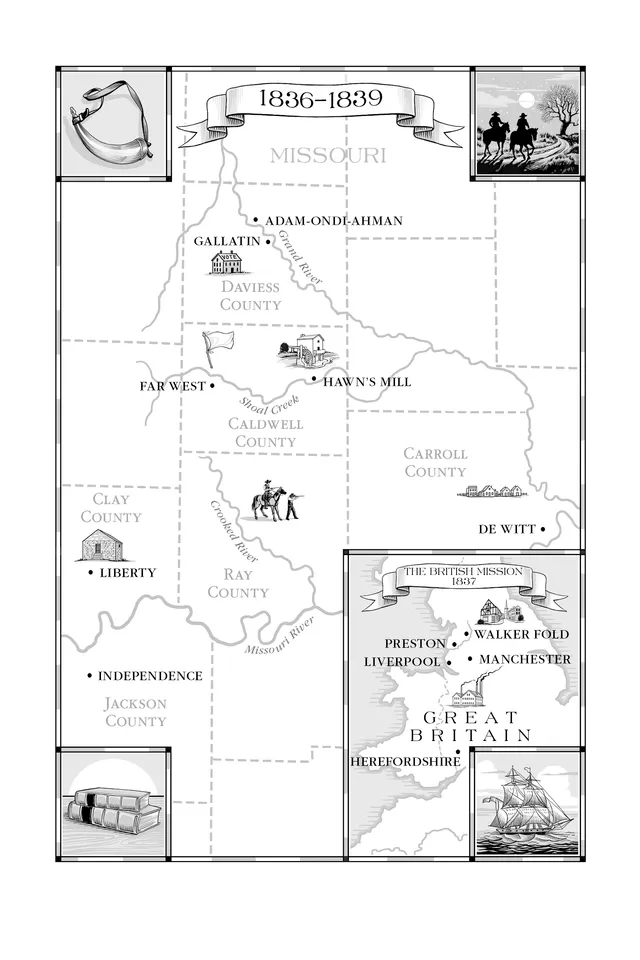
🗓 Key Events
- Summer 1831: Joseph Smith designated Independence, Missouri, as the “center place” of Zion — the New Jerusalem — and directed early Saints to begin gathering there.
- 1832–1833: Tensions rose between the Latter-day Saints and local Missourians. Cultural, religious, and economic differences fueled suspicion and hostility.
- July 1833: A mob of Jackson County residents destroyed the Evening and Morning Star printing office (the Church’s publication) and tarred and feathered Bishop Edward Partridge.
- November 1833: Armed conflict broke out. Several skirmishes occurred between the Saints and the Missouri settlers.
- Early November 1833: Under threats of death and further violence, the Saints agreed to leave Jackson County.
Most were driven out between November 4 and November 7, 1833, crossing the Missouri River into Clay County, where they took temporary refuge.
📍 Aftermath
- By 1834, virtually all members had been forced out of Jackson County.
- The Lord through the Prophet, Joseph Smith, later organized Zion’s Camp (1834) to aid and reestablish the displaced Saints, but the effort did not result in their return.
- The main body of the Church eventually gathered farther north in Caldwell County, Missouri.
- The citizens of Clay County were moved by the difficult situation caused by the residents of Jackson County. They opened the county to the saints and did as much as they could to alleviate their suffering.
- Although the residents of Clay County had pity on the saints, they made it clear that the saints were only welcome in Clay County temporarily.
- 1835-1836 In the next few years, the saints in Clay County began making permanent homes as new members from outside Missouri came to “establish Zion.” These new members also began purchasing lands and building homes. This started to strain the relationship between the residents of Clay County and the Church.
- March 1836. The Kirtland Temple was finished and dedicated in March, 1836. Because of the high cost of building the temple, the Church was heavily in debt. Members throughout the country had already donated much of their money to building Zion and the temple.
- March 1836 Late Spring: With the Saints in Missouri needing a new place to settle, Joseph felt even more pressure to raise money to buy lands. He decided to open a church store near Kirtland and borrowed more money to purchase goods to sell there. The store had some success, but many Saints took advantage of Joseph’s kindness and trust, knowing he would not refuse them credit at the store.
- By the end of July, neither the store nor anything else church leaders tried had eased the church’s debt. Desperate, Joseph left Kirtland with Sidney, Hyrum, and Oliver for Salem, a city on the East Coast, after hearing from a church member who thought he knew where to find a cache of hidden money. No money came of the lead when they arrived in the city, and Joseph turned to the Lord for guidance.
- In July 1836, William Phelps and other church leaders in Clay county wrote the prophet to tell him that local officials had summoned church leaders to the courthouse, where they discussed the Saints’ future in their county. The officials had spoken calmly and politely, but their words left no room for compromise. The Saints had worn out their welcome in Clay County.
- Since the Saints could not return to Jackson County, the officials recommended that they look for a new place to live—somewhere they could be by themselves. The church leaders in Clay County agreed to leave rather than risk another violent expulsion.
- December 1836. Caldwell County created by the Missouri State Legislature as a place for the Latter-day Saints to relocate.
- 1837 January To help alleviate the financial crisis, the Church organized an “anti-banking company” called the Kirtland Safety Society in January 1837. They began issuing their own notes (currency) and doing business in Kirtland and the surrounding area.
- 1837 February, the Sate of Ohio refused to grand the Kirtland Safety Society a charter. The public lost confidence in the “anti-bank.” A few antagonists of the Church and Jospeh used this to deplete the Safety Society’s ability to hold money in reserve. By late spring and early summer, a region financial panic occurred throughout the United States and the Kirtland Safety Society collapsed.
- The collapse of the Society’s bank only fueled negative feelings about Joseph Smith and the Church. Many members of the Church, including some apostles, apostatized, left the Church, and began bitterly opposing Joseph Smith, making threats on his life.
- By late spring of 1837, many of the Saints in Zion were now settled along a stream called Shoal Creek, 50 miles northeast of Independence, MO. They had founded a town called Far West, in Caldwell County—a county which had been organized by the Missouri legislature for the Saints’ ongoing problems with their neighbors.
Leave a Reply